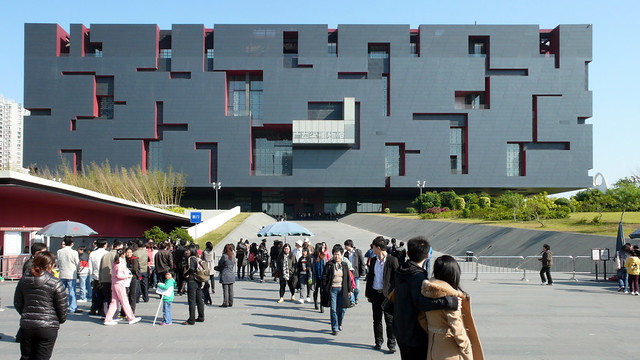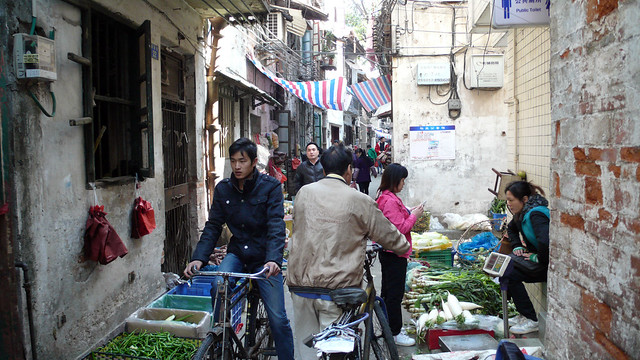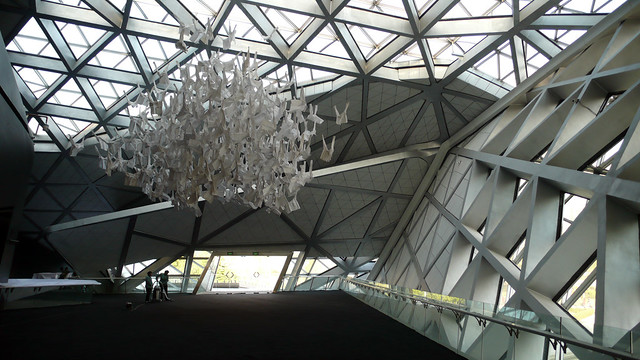

[In December, I helped lead a tour of Architecture students through eastern China. The following posts will be my brief impressions of the cities we visited. Today: Guangzhou.]

[Shamian Island]
Guangzhou, perhaps more than any other city, represents the diversity of urban form present in China’s post-colonial cities. From the well-preserved Old Town, the colonial Shamian Island, to the “hanging gardens” of Guangzhou’s elevated highways (which soften the brutal infrastructure of the city, and provide shade for informal businesses below) and the lifeless modernism of Futian, Guangzhou is nothing if not a collection of diverse urban ideas, a kind of living museum of urbanism.
Guangzhou has been a prominent port for millennia (Wikipedia traces the city’s history back to 206 BC, when it was the Capitol of the Nanyue kingdom), but its modern history starts more or less with the Portuguese’ arrival in the 1500s. Long before other Chinese cities were “opened” for international trade, Guangzhou was bustling. Along with Macau, it represented one of the two points-of-entry for foreign traders, but while Macau was ceded to the Portuguese (and, thus, developed an urban form characteristic of European colonies), Guangzhou remained firmly under Chinese (Qing Dynasty) control, and developed accordingly. Foreigners were restricted, first, to the “Thirteen Factories” and, later, to Shamian Island, a reclaimed “sandbar” which became a hub of European influence in the city.

[Shamian Island]
Today, Shamian island is a quiet, leafy oasis, whose rational grid-layout and neoclassical facades form a distinctive European enclave in the city. The island remains somewhat disconnected from the surrounding streets, due to its physical separation by a large canal and (now) an elevated highway. While tiny compared to the concession areas of, say, Shanghai, the island represents a “pure” colonial urbanism that one can’t find in Shanghai, where mass migration and speculative development led to the emergence of hybrid typologies. Here, stately neo-classical villas prevail.
Just across the canal, Guangzhou’s lively market streets represent an alternative urbanism, with clusters of narrow lanes bustling with activity. These blocks are home to every kind of market imaginable, from fruit stands to traditional medicine shops. Pet shops sell bunnies and puppies on one street, butchers sell skinned rabbits and dog meat one street over. The contrast between these frenetic lanes and the serene boulevards of Shamian island is remarkable – and all available within a ten minute walk.


Elsewhere, Guangzhou is engaged in a process of modernization, a re-development strategy focused on the construction of massive civic squares anchored by impressive architectural icons, but sorely lacking the kind of urban activity one should expect in a city center. The central plaza in Guangzhou’s Futian district is about the same size and scale as Shenzhen’s Civic Center, similarly anchored by cultural buildings, and equally devoid of life.

(I exaggerate a bit: these large plazas are nowhere near as soul-crushing as, say, Tiananmen, but the low-intensity activity can’t compare to the bustling market streets elsewhere in the city. The squares are severely under-programmed, and I see no reason to come back once you’ve seen the Opera House, the Museum, and the Canton Tower. )

While the comparison to Shenzhen is interesting – both were among the first “Special Economic Zones” – it only goes so far. Guangzhou has an incredibly long history, compared to which Shenzhen really was a “tabula rasa.” Guangzhou suffers somewhat from the comparison, if only because we can imagine what was demolished to make room for the new, massive, civic center. Guangzhou had a developed, heterogeneous urban form, where any “modernization” project could be seen as destructive.
Aside from the urban issues, Guangzhou’s central plaza provides a lesson regarding construction quality in China today, and the validity of metaphor as design concept.
Zaha Hadid’s opera house, ostensibly based on the concept of “two stones in the river” is already falling into disrepair, due in part, no doubt, to the complexity of the geometry that would prove challenging in any country, but especially so in China where the speed of the design and construction process makes quality control a significant concern.
The design of the opera house seems unnecessarily complex, and has little to do with the functional requirements of the program, the auditorium volumes only loosely wrapped by the containing envelope, whose tortured forms have no relation to the interior space (compare to OMA’s Casa De Musica in Oporto, Portugal, where the audacious shape of the building is driven directly by the volumetric form of the auditorium).


The Guangdong Museum, by contrast, is constructed with straightforward details, right angles, and a material sensibility that seems appropriate for the local climate and fully within the capabilities of the local contractors. While the “Chinese Box” metaphor may be a bit of a stretch, the array of rectangular gallery spaces around a central atrium seems to make sense for a museum, allowing for lighting control within the galleries, while allowing the quality of light in the circulation zone to vary over the course of a day.


The courtyard typology has precedent in the local vernacular. The functionally-useful metaphor, simple, elegant details, and the typological reference to local traditions combine to make this work of architecture a much more successful design than the opera house it faces across the plaza. These subtle design choices don’t alleviate the problems of the massive plaza, however, and you need to look to other areas of Guangzhou, mentioned above, for the real life of the city.
Luckily, modernization projects have not robbed Guangzhou of its unique character - because other areas of town have been preserved - and their existence only adds to the diverse heterogeneity of Guangzhou’s urban form.
---
As always, more photos on the author's Flickr stream: Architecture by City: Guangzhou.
This essay was cross-posted to the author's blog, Tenuous Resilience.
reflections on architecture and urbanism in China.
No Comments
Block this user
Are you sure you want to block this user and hide all related comments throughout the site?
Archinect
This is your first comment on Archinect. Your comment will be visible once approved.